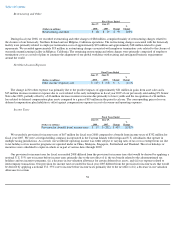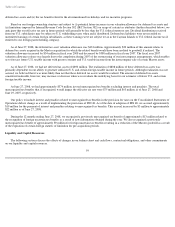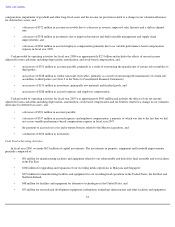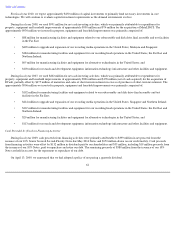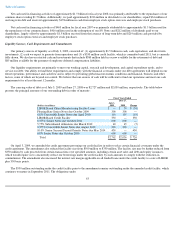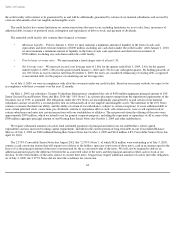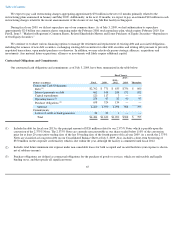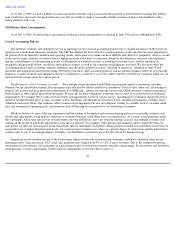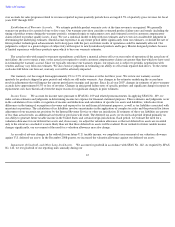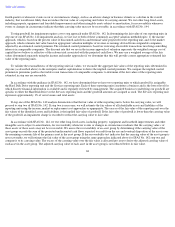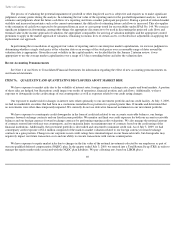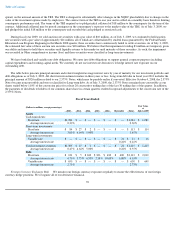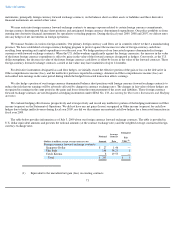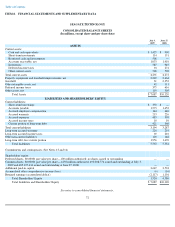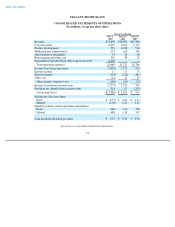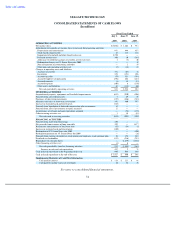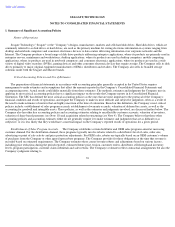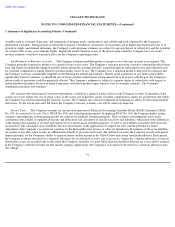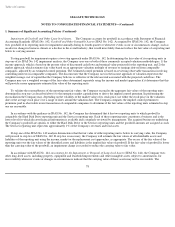Seagate 2008 Annual Report Download - page 70
Download and view the complete annual report
Please find page 70 of the 2008 Seagate annual report below. You can navigate through the pages in the report by either clicking on the pages listed below, or by using the keyword search tool below to find specific information within the annual report.
Table of Contents
fourth quarter or whenever events occur or circumstances change, such as an adverse change in business climate or a decline in the overall
industry, that would more likely than not reduce the fair value of a reporting unit below its carrying amount. We test other long-lived assets,
including property, equipment and leasehold improvements and other intangible assets subject to amortization, for recoverability whenever
events or changes in circumstance indicate that their carrying value may not be recoverable, in accordance with SFAS No. 144.
Testing goodwill for impairment requires a two-step approach under SFAS No. 142. In determining the fair value of our reporting units in
step one of our SFAS No. 142 impairment analysis, we use one or both of these commonly accepted valuation methodologies: 1) the income
approach, which is based on the present value of discounted cash flows and terminal value projected for the reporting unit, and 2) the market
approach, which estimates fair value based on appropriate valuation multiples of revenue or earnings derived from comparable companies,
adjusted by an estimated control premium. The estimated control premium is based on reviewing observable transactions involving controlling
interests in comparable companies. The discount rate that we use in the income approach of valuation represents the weighted average cost of
capital that we believe is reflective of the relevant risk associated with the projected cash flows. We may use a weighted average of the fair
values determined separately using the income and market approaches if we determine that this will provide a more appropriate estimated fair
value of the reporting units.
To validate the reasonableness of the reporting unit fair values, we reconcile the aggregate fair values of the reporting units determined in
step one (as described above) to the enterprise market capitalization to derive the implied control premium. We compare the implied control
premium to premiums paid in observable recent transactions of comparable companies to determine if the fair values of the reporting units
estimated in step one are reasonable.
In accordance with the guidance in SFAS No. 142, we have determined that we have two reporting units to which goodwill is assignable:
the Hard Disk Drive reporting unit and the Services reporting unit. Each of these reporting units constitutes a business and is the lowest level for
which discrete financial information is available and is regularly reviewed by management. The acquired businesses underlying our goodwill are
specific to either the Hard Disk Drive or the Services reporting units and the goodwill amounts are assigned as such. The Services reporting unit
represents approximately 1% of our revenues and total assets.
If step one of the SFAS No. 142 analysis demonstrates that the fair value of either reporting unit is below the carrying value, we will
proceed to step two of SFAS No. 142. If step two is necessary, we will estimate the fair values of all identifiable assets and liabilities of the
reporting unit using the income, market or replacement cost approaches as appropriate. The excess of the fair value of the reporting unit over the
fair values of the identified assets and liabilities is the implied fair value of goodwill. If the fair value of goodwill is lower than the carrying value
of the goodwill, an impairment charge is recorded to reduce the carrying value to fair value.
In accordance with SFAS No. 144, we test other long-lived assets, including property, equipment and leasehold improvements and other
intangible assets subject to amortization, for recoverability whenever events or changes in circumstances indicate that the carrying value s of
those assets of those assets may not be recoverable. We assess the recoverability of an asset group by determining if the carrying value of the
asset group exceeds the sum of the projected undiscounted cash flows expected to result from the use and eventual disposition of the assets over
the remaining economic life of the primary asset in the asset group. If the recoverability test indicates that the carrying value of the asset group is
not recoverable, we will estimate the fair value of the asset group using the same approaches indicated above for SFAS No. 142 step two and
compare it to its carrying value. The excess of the carrying value over the fair value is allocated pro rata to derive the adjusted carrying value of
each asset in the asset group. The adjusted carrying value of each asset in the asset group is not reduced below its fair value.
68


